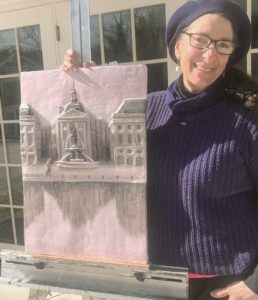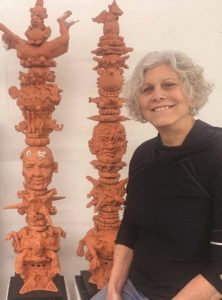Editor’s note: As we went to press with this issue we learned that the opening of the sculpture show by the artists profiled in this article, which was scheduled for Thursday, will not take place. The Independent will continue to report on the work of artists in the community as an essential part of Outer Cape life.
The two winter residents at Truro Center for the Arts at Castle Hill, Juliet Ehrlich and Rachel Stevens, are ceramic sculptors, not functional potters, and their work is as distinct from traditional pottery as the two artists are from each other. Ehrlich and Stevens have been sharing a residence and working side by side seven days a week since January in a studio at Castle Hill’s main campus on Meetinghouse Road.
Ehrlich, from Louisville, Ky., has worked and taught around the world and apprenticed with a master potter in New Zealand in her teens. The sculptural form she works in, bas-relief, projects outward from a flat surface.

“My work is both sculpture and painting, and that’s what makes it unique,” Ehrlich says. “This developed for me slowly from being a potter. I would embellish small things, then I wanted a larger canvas, and then I was taken with color.”
The three-dimensionality of bas-relief is part real and part filled in by the viewer. “It’s like a relationship,” Ehrlich says. “You see another human being who intrigues you; you want to know more. It’s like that for a painting or a sculpture — it begins with a moment of entry. Something grabs you, you become fascinated, and suddenly you’re moved.”
Ehrlich has had commissions from private clients and public institutions, in clay and in bronze, to portray a wide range of subjects — from botany to portraiture, historical to cultural. “Diversity is my trademark,” she says. “Each commission is very different. The act of creation brings into being ideas.”
Ehrlich speaks exuberantly about her art. “The medium itself, clay, is so boundless in its capacity to move, you can do almost anything with it,” she says. “The engineering and firing is a whole in-between realm. I sand, I grout, then I move into painting. And I love that! I’m fascinated by the nuance of color and the fact that light and color are both fugitive and chameleon-like in their nature.”
Her residency at Castle Hill has been a joyful experience. “I arise and I am immediately tuned to nature and her signals, whether it is raining or windy,” she says. “Nature expressed in its destructive form, or its lilting, beautiful, spring form — they are all poems, and they ignite my senses.”
Stevens, Ehrlich’s studio mate, works in figurative ceramic sculpture derived from her imagination and memory. During her residency, she has created some free-standing and wall-hanging pieces, as well as four totems assembled of 14 to 15 elements stacked one on top of the other.
“Each of my pieces is an original, one of a kind,” Stevens says. “I look at my art and I think: what’s that all about? It’s a hodgepodge of everything: animals, geometric forms, people. And that’s life. We’re all tied together — the natural world, the world of humanity, the products of humanity. Then throw in the rapid change, disillusionment, the chaos of things, everything I’ve done in the past — coming together in this explosion of creativity.”

Stevens is an untrained artist who has worked as a slot casino cashier, a stonemason, a vegan chef, a paralegal, and a West Texas criminal defense lawyer. “About 1984, in the middle of my second marriage, I had two small children in Austin,” she says. “It was rainy, so I needed something to do with my kids. I bought some clay, and we sat down together. They lost interest after five minutes, and here I am, 35 years later, still doing it.” She laughs.
“I’ve never had a model,” Stevens says. “When I first started, I did some portraiture from photographs. And I’ve used my own body at times in the mirror, just to see how things work. I have a pretty sound knowledge of anatomy from being a trial lawyer. I had a lot of personal injury cases, so I became very familiar with injuries and that sort of thing. And I tend to be a very good observer of faces, bodies, different shapes. People fascinate me.”
Stevens recently published a memoir, Blowing Up Rachel: A Non-binary Trans Woman’s Dialogue With Each Other, about her experience transitioning nearly two decades ago. “I am kind of conflicted,” she says. “I’ve always been conflicted about a lot of things. My memoir is one part of me talking to the other part of me for a couple of hundred pages.”
Stevens sees her life story and her identity as an artist as inextricable. “I have been through a lot, with marriages and children and transition, different jobs,” she says. “It has opened me up to a lot of possibility. I’ve always had this creative urge and, of course, I’ve had to reinvent myself in many ways over the years. I’m not sure what came first, the creative urge or the need to reinvent myself. I’m not sure where the creative urge comes from, or what fortifies it in people who are driven by it, such as I am. But yes, it’s made me embrace change and take risks, and that informs my art. Some people find my artwork disturbing, because it’s very expressive. It can trigger emotions in some people that they don’t like. Hopefully it won’t be too demanding.”



